
Previous entry:
More on the Research Thing
Next Entry:
Some Garden Planning
Home:
One Truth For All
| Sun | Mon | Tue | Wed | Thu | Fri | Sat |
|---|---|---|---|---|---|---|
| 1 | 2 | 3 | 4 | 5 | ||
| 6 | 7 | 8 | 9 | 10 | 11 | 12 |
| 13 | 14 | 15 | 16 | 17 | 18 | 19 |
| 20 | 21 | 22 | 23 | 24 | 25 | 26 |
| 27 | 28 | 29 | 30 | 31 |
Archives
- May 2008
- April 2008
- March 2008
- February 2008
- December 2007
- November 2007
- October 2007
- September 2007
- August 2007
- July 2007
- May 2007
- April 2007
- March 2007
- February 2007
- December 2006
- November 2006
- October 2006
- September 2006
- August 2006
- July 2006
- June 2006
- May 2006
- April 2006
- March 2006
- February 2006
- January 2006
- December 2005
- November 2005
- October 2005
- September 2005
- August 2005
- July 2005
- June 2005
- May 2005
- April 2005
- March 2005
- February 2005
- January 2005
- December 2004
- November 2004
- October 2004
- September 2004
- August 2004
- July 2004
- June 2004
- May 2004
- April 2004
- March 2004
- February 2004
- January 2004
- December 1969
May 9, 2007
Thesis Studio Eats My Brain
All I can think about lately is my thesis. This is a good thing, but weird. For example, I haven't been attending plant sales I'd planned to attend because I just can't think about gardening. And I recently decided to drop my Construction Management minor because it would allow me to take only thesis studio for the next two quarters. Strange, huh?
Anyhow, I figured I'd show you all some of what I've been working on. Most of it is inside my head; I've been reading 3-5 books a day about spatial psychology and bioethics, which is great but doesn't give a lot of pretty drawings. So in addition, I've been making lots of little diagrams of complex systems like this:
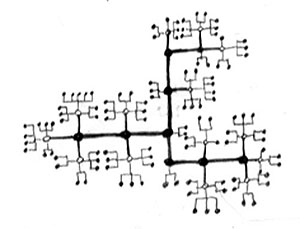
Technorati Tags: design, drawings, school, thesis
What I'm trying to do is understand how users inhabit a space, and how teams work together dynamically. If you imagine each of the outside dots as a person, you can then follow them around as they meet with a small team, then in a larger group, then maybe in a small team again.
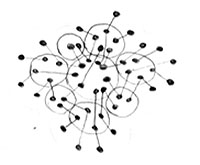
I've also been interviewing researchers to better understand how they inhabit the space they have now. As we talk, I make these little diagrams of their movements through the space.
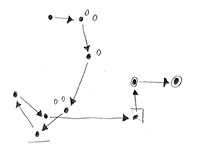
We're writing our programs (descriptions of the types of spaces in our buildings) right now, so I have also been compiling lists of types of spaces required, and sorting them by intimacy of setting.
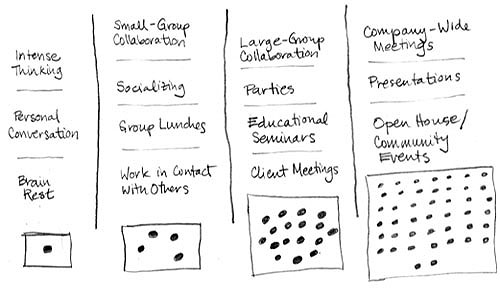
As I worked with those diagrams and got a better idea of the spaces needed to conduct research, I began to define spaces around my little dots and then group them into workgroups that are doing related and unrelated work.
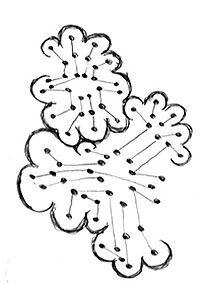
Then, to better understand what I was doing, I made this system diagram, where I put modules of different types of spaces together and made larger modules. My experience has showed me (and my research agrees with this) that smaller groups work more effectively than large ones. So I'm trying to limit team sizes to 4-8 people, at least in close contact. Of course those teams will get together and form larger teams for complex projects, but for sitting-at-desk time, small is good.
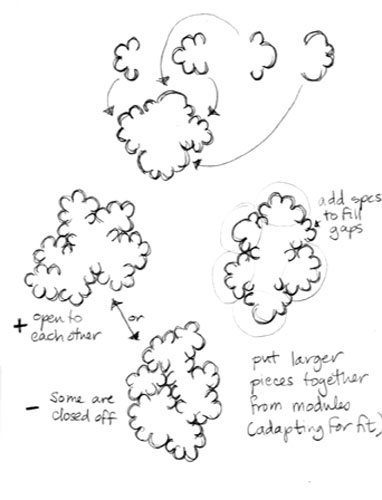
In parallel, I've been exploring biological arrangements of space. Here's a cellular formation from the vascular system of a tree (I drew this from a picture in a book, so it's vastly simplified).
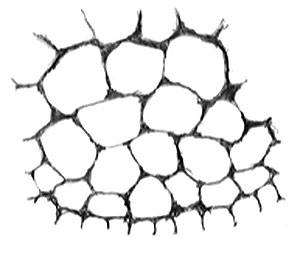
Cellular formations take on a lot of shapes, but I'm most interested in this sort of larger-space flat shape, with interesting interstitial spaces. This is another drawing done from a book, a simplified and combined version of several different things: a piece of plant material, a dragonfly wing, and a skin layer.
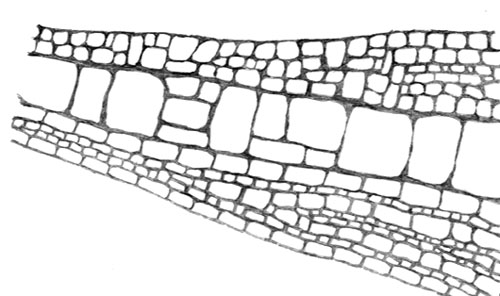
Because I'm going to be designing for an urban site (I'm not decided, but it's somewhere along Geary in San Francisco, near USCF's Mount Zion campus), I have also been looking at verticality. These drawings are explorations of how spaces can be stacked and connected around a vertical core.
Clearly, this one is based on a spine. But it also borrows from the form of neurons, and I think it has a bit in common with my little movement diagrams.
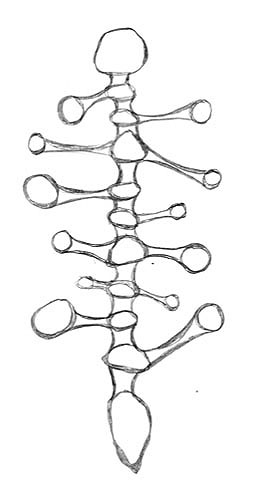
The problem with high rises is that they end up being very bland, spatially. Lots of stacked floorplates. So I was thinking about how to take the sort of bone-like, spine-like structure and make it less flat. I call this drawing "dumbbells."
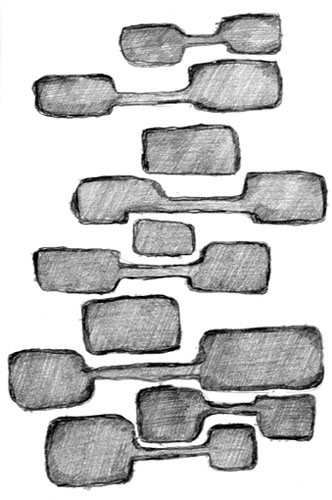
That's not nearly everything I've been working on. I have a bunch more drawings and some models and some photo studies on transparency, but this post is long enough.
Posted by ayse on 05/09/07 at 10:48 AM
Leave a comment